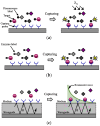Complementary Metal-Oxide-Semiconductor-Based Magnetic and Optical Sensors for Life Science Applications
- PMID: 39409303
- PMCID: PMC11478837
- DOI: 10.3390/s24196264
Complementary Metal-Oxide-Semiconductor-Based Magnetic and Optical Sensors for Life Science Applications
Abstract
Optical and magnetic sensing methods are integral to both research and clinical applications in biological laboratories. The ongoing miniaturization of these sensors has paved the way for the development of point-of-care (PoC) diagnostics and handheld sensing devices, which are crucial for timely and efficient healthcare delivery. Among the various competing sensing and circuit technologies, CMOS (complementary metal-oxide-semiconductor) stands out due to its distinct cost-effectiveness, scalability, and high precision. By leveraging the inherent advantages of CMOS technology, recent developments in optical and magnetic biosensors have significantly advanced their application in life sciences, offering improved sensitivity, integration capabilities, and reduced power consumption. This paper provides a comprehensive review of recent advancements, focusing on innovations in CMOS-based optical and magnetic sensors and their transformative impact on biomedical research and diagnostics.
Keywords: CMOS; PoC diagnostic; magnetic sensors; optical sensors.
Conflict of interest statement
The authors declare no conflict of interest.
Figures

















References
-
- Syu Y.-C., Hsu W.-E., Lin C.-T. Field-effect transistor biosensing: Devices and clinical applications. ECS J. Solid State Sci. Technol. 2018;7:Q3196. doi: 10.1149/2.0291807jss. - DOI
Publication types
MeSH terms
Substances
LinkOut - more resources
Full Text Sources

